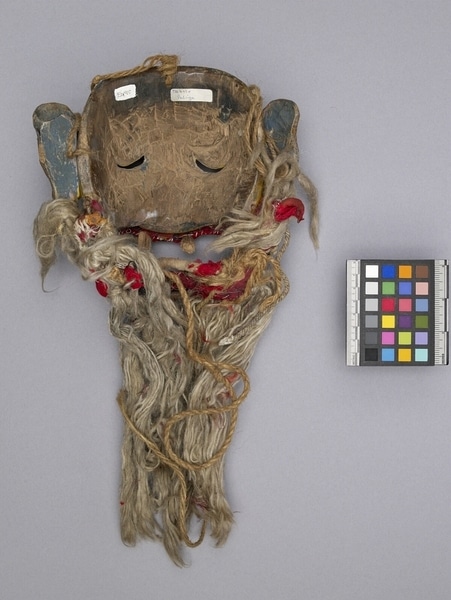Mask Item Number: Eh95 from the MOA: University of British Columbia




Description
Mask depicting a humanoid face painted with glossy enamel in a medium yellow with orange, red, black, white and green lines decorating the face. There are crescent-shaped slits under each eye. Ears painted same colours as face, also decorated with lines. The beard and sideburns are of grey wool. Two upper teeth are loosely attached to the upper lip, and a hinged lower jaw is made of wire covered in red fabric. A label on the reverse reads, "Tabele Paliya."
History Of Use
Worn during curing ritual of the Sanni Yakuma ceremony, part of the Tovil series of dramas performed by Sinhalese ritual specialists and dancers. The Sanni Yakuma is intended to combat diseases and afflictions caused by the Sanni group of demons. These consist of 18 or more apparitions of the chief demon, Maha-kola-sanni. The officiating healer honours Buddha, then appeases the demons with offerings, dancing, and chanting. This mask is probably Tabele Paliya, who comes at the end of the ceremony.
Cultural Context
exorcism
Iconographic Meaning
Yellow face colour is used for demons causing disease; red mouth signifies a demon. Tabele refers to 'king coconut' which is a food with medicinal properties, therefore Tabele Paliya may be associated with medicinal 'blessing'.
Item History
- Made in Sri Lanka
- Collected during 1978
- Owned by Jason Schoonover before June 10, 1982
- Received from Jason Schoonover (Seller) and Museum of Anthropology Shop Volunteers (Funding source) on June 10, 1982
What
- Name
- Mask
- Identification Number
- Eh95
- Type of Item
- mask
- Material
- wool fibre, wood, paint and cotton fibre ?
- Manufacturing Technique
- carved and painted
- Overall
- height 39.8 cm, width 20.4 cm, depth 9.4 cm
Who
- Culture
- Sinhalese
- Previous Owner
- Jason Schoonover
- Received from
- Jason Schoonover (Seller) and Museum of Anthropology Shop Volunteers (Funding source)
Where
- Holding Institution
- MOA: University of British Columbia
- Made in
- Sri Lanka
When
- Collection Date
- during 1978
- Ownership Date
- before June 10, 1982
- Acquisition Date
- on June 10, 1982
Other
- Condition
- fair
- Accession Number
- 0812/0011